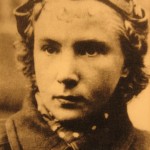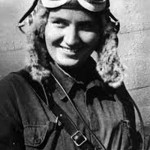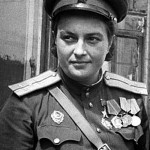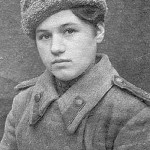World War II, or the Second World War, took place from September 1939 to September 1945 and involved a majority of the world’s nations. World War II was the largest global war to have ever been fought. The urgency of mobilizing entire populations of the nations involved made the role of women inevitable. By 1945 millions of women were working building ships, aircraft, vehicles, and weapons. Women also provided logistic support for soldiers and entered areas of work that were previously dominated by men. Thousands also enlisted as nurses serving on the front lines. However combat roles were generally prohibited to women in World War II except for in the Soviet Union (Russia).
Russia, or the Soviet Union as it was known at the time, was at peace with Germany during the first part of World War II until June 22, 1941, when German forces launched a surprise attack against the Soviet Union. This part of World War II was called the “Eastern Front”. The battles of the Eastern Front were known by their unprecedented violence, massive destruction, and the immense loss of life due to combat, starvation, exposure, disease, and massacres.
Russian women played a major role in World War II. While most worked in factories and agriculture to free up men to fight in the armed forces, a sizable number of Russian women served in front line combat. There were over 800,000 women who served in the Soviet Armed Forces during the war. Nearly 200,000 were decorated and 89 eventually received the Soviet Union’s highest award; Hero of the Soviet Union, here are the stories of a few of them:
Mariya Oktyabrskaya was a Soviet tank driver during World War II. She was the first female tank crew member to be awarded the Hero of the Soviet Union award. When World War II started, Mariya was married to an Army Officer. During the war her husband was killed fighting the Germans. After hearing the news she decided to join the Army. She sold all of her possessions to raise enough funds to donate a tank for the Army. Her only requirement was that she would be allowed to drive it. Surprisingly the Soviet authorities agreed to this, realizing the publicity opportunities they could gain. The tank Mariya purchased and donated was a T-34 medium tank. Many of her fellow male soldiers saw her as a publicity stunt and a joke, but this attitude quickly changed when Mariya took part in her first battle in which she destroyed several machine-gun and artillery positions. Mariya’s tank was also the first one of her unit to breach the German positions. In January of 1944 during an attack, a German artillery shell exploded into her tank’s tracks, disabling it. Mariya immediately got out of the tank and began to repair the damaged track while dodging enemy gun fire. She managed to repair the track, but was hit in the head by shrapnel and lost consciousness. Her tank was hit and destroyed shortly afterwards, killing the entire crew. After the battle Mariya was transported to a military hospital where she remained in a coma until she died two months later.
Lydia Litvyak was a fighter pilot in the Soviet Air Force during World War II. Born in Moscow in 1921, Litvyak became interested in becoming a pilot at the age of 14 and enrolled in a flying school. She was a fast learner and later graduated from the Kherson military flying school. She became a flight instructor and before the German invasion had already trained 45 pilots. Litvyak flew her first combat flights in the summer of 1942. Shooting down at least twelve German airplanes over a total of 66 combat missions, Lydia is the world’s first female fighter pilot to shoot down an enemy plane and the world’s first female fighter pilot to earn the title of “fighter ace”. She was shot down and killed in 1943 during the Battle of Kursk as she attacked a group of German planes.
The 588th Night Bomber Regiment was most highly-decorated all-female unit in the Soviet Air Force. Formed by Colonel Marina Raskova and led by Major Yevdokia Bershanskya, the unit was used to fly night missions against German troops on the Eastern Front. Flying over 23,000 missions thirty of its pilots died in combat. The aircraft they were equipped with was obsolete PO-2 biplanes intended for crop-dusting and training. Each plane could only carry two bombs at a time, so several missions per night were often carried out. Although the aircraft were slow, the female pilots made use of their excellent maneuverability. A favorite technique was to idle the engine near the target and slowly glide to the point at which the bombs were dropped. German soldiers nicknamed the female pilots “Night Witches” because the planes sounded like flying brooms to the soldiers on the ground while making the attack runs. Due to the weight of the bombs and the low altitude of the flights the pilots carried no parachutes. Twenty-three of the pilots were named: “Hero of the Soviet Union” Marina Raskova died on January 4, 1943, when her aircraft crashed while attempting to make an emergency landing. Yevdokia Bershanskya survived the war and lived until 1982.
Born in 1916, Lyudmila Pavlichenko was studying history at Kiev University in 1941 when Germany began its invasion of the Soviet Union. She was among the first volunteers at the recruiting office, where she requested to join the infantry and was assigned as a sniper. Pavlichenko became one of over 2,000 female snipers to serve in the Soviet Army. At the time the Soviet Union was deploying female snipers because it was believed that they were patient and cunning. They were also thought to be more resilient than men under combat stress, and more resistant to cold. Snipers on both sides of the Eastern Front were hunted, hated and despised, with many captured snipers being executed. Only about 500 of the Soviet female snipers survived World War II. Pavlichenko’s total during World War II was 309 confirmed kills. In June of 1942, she was wounded and because of her growing status was withdrawn from combat and was sent to the United States and Canada for a publicity visit. Pavlichenko became the first Soviet citizen to be received by a U.S. President when Franklin Roosevelt welcomed her to the White House. The United States Government gave Pavlichenko a Colt pistol and in Canada she was presented with a Winchester rifle which is now on display at a museum in Moscow. Lyudmila Pavlichenko never returned to combat but became an instructor and trained snipers until the end of World War II. She finished her schooling after the war and became a research assistant; she died at the age of 58 in 1974.
Roza Shanina was another female sniper who served in the Soviet Army during World War II.
Shanina was born in April 1924 in the Russian village of Yedma. Details of her life are known from the surviving diaries she kept. Attending the “Central Female Sniper Academy” after joining the Soviet Army, Shanina scored highly and graduated from the academy with honors. Shanina was offered to stay as an instructor there, but refused. In April 1944 she joined the 184th Rifle Division where she was made the commander of the female sniper unit. Shanina started keeping a diary although
iaries were strictly prohibited in the Soviet Army. Shanina enjoyed writing and would often send letters to her village and to her friends. Several months after being sent into combat, Shanina wrote in her diary that “she was now killing the enemy in cold blood and saw the meaning of her life in her actions”. She also wrote that if she had to do everything over again, she would still strive to enter the sniper academy and would go to the front again. During one battle she would crawl through a muddy trench every day at dawn to a specially camouflaged pit which overlooked German-controlled territory. She wrote in her diary, “The unconditional requirement to outwit the enemy and kill him became an irrevocable law of my hunt”. In December 1944, a German sniper shot Shanina in her right shoulder, recovering from this wound she returned to the front lines. Shanina was severely injured while helping a wounded officer on 27 January 1945, found by fellow soldiers and despite attempts to save her, Shanina died the following day. Her final total of confirmed kills was 54.
Tatiana Baramzina was born in the city of Glazov in December of 1919. After graduating from the Glazov State Institute, she spent two years as a kindergarten teacher. After Germany invaded, Tatiana started attending nursing school in the evenings, while also training to become a sniper. In June 1943 she was sent to a sniper school, and upon graduation she was sent to the front lines where she killed 16 enemy soldiers in three months. On July 5, 1944 Tatiana’s unit was parachuted behind enemy lines as part of a plan to block the retreat of German forces by seizing the crossroads near the village of Pekalin. Surprised by German Soldiers before reaching the crossroads, heavy fighting broke out and the unit took heavy casualties. After killing some German soldiers, Tatiana helped care for some of the wounded soldiers because of her medical training. She was captured after the Germans re-took the area and was tortured in an attempt to have her give up information about the operation. After refusing to give up any information, Tatiana was executed by the Germans. She posthumously achieved Hero of the Soviet Union status on March 24, 1945.
In addition to serving in the Soviet armed forces, women also served in Soviet partisan units, partisan units were resistance forces formed behind the German lines. The primary objective of the Soviet partisan units was the disruption of the German supply lines, especially roads, railroads, and communications. Zoya Kosmodemyanskaya was born in 1923 in a village near the city of Tambov. In October of 1941, while still a high school student in Moscow, she volunteered for a partisan unit. She was assigned to a partisan unit and was sent behind German lines where they planted mines in roads and cut communication cables. On November 27, 1941 Zoya received an assignment to burn buildings used by a German unit in the village of Petrischevo. Following orders Zoya managed to set fire to a couple of buildings but was caught by the Germans. She was tortured and interrogated throughout the night but refused to give up any information. The following morning Zoya was marched to the center of the village and publically hung. Her final words were reported to be “Comrades! Why are you so gloomy? I am not afraid to die! I am happy to die for my people!” and to the Germans she said, “You’ll hang me now, but I am not alone. There are two hundred million of us. You can’t hang us all.” The Germans left Zoya’s body hanging for several weeks. Eventually she was buried before the Soviets regained that territory in January 1942.






